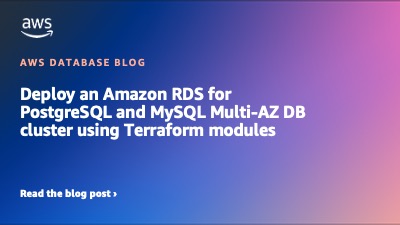AWS Database Blog
Category: Advanced (300)
Deploy an Amazon RDS for PostgreSQL and MySQL Multi-AZ DB cluster using Terraform modules
Selecting the right cloud management tool is extremely important for many enterprises. In the post 5 Tips for Keeping Pace with AWS’s Innovation, we briefly discussed the high-level strategies to overcome the challenges of continuous improvement and drive innovations in your organization. In this post, we show how infrastructure as code (IaC) solutions built with […]
Speed up database migration by using AWS DMS with parallel load and filter options
Some migrations might take a long time because they have large tables. However, AWS Database Migration Service (AWS DMS) features such as parallel load and filters might be able to help speed up this process. AWS DMS is a data migration service that has robust features for supporting both homogenous and heterogeneous database migrations. AWS […]
Improve application availability on Amazon Aurora
An Online Transaction Processing (OLTP) database is a key building block of a highly available application. Business-critical workloads can leverage Amazon Aurora database clusters in Multi-AZ configuration to help improve their overall uptime, and reduce the impact of availability-related events such as Multi-AZ failovers. In this post, we discuss aspects of Amazon Aurora related to […]
Monitor SQL Login creation on Amazon RDS for SQL server
Maintaining database security is indispensable for the success of any organization. Implementing database user authentication and authorization is an important step in securing a database system. Conventional database authentication is based on a username-password mechanism. This process requires constant time and effort from both DBAs and end users to manage the credentials. In contrast, incorporating […]
Data modelling for an internet-scale online transactional system using Amazon DynamoDB
Relational database management system (RDBMS) technology was the preferred choice for data storage for decades. In recent years, the rise of internet-scale applications and exponential data growth have challenged the way industries have designed their database strategies. Organizations are seeing clear benefits in scalability and performance by migrating mission-critical online transactional systems built on RDBMS […]
Configure Kerberos authentication for Amazon RDS for PostgreSQL without joining an Active Directory domain
Organizations that adopt centralized authentication mechanisms gain the following benefits: Enhanced security posture: Centralized authentication enables quick addition or removal of user access throughout the network, giving organizations improved security and the ability to respond quickly to security threats. Scalability: By controlling access through a centralized database, organizations can scale their network and minimize performance […]
Using an Oracle Database Gateway to connect Amazon RDS Custom for Oracle to PostgreSQL
Amazon Relational Database Service (Amazon RDS) Custom for Oracle allows you to run Oracle databases on AWS, giving you some of the benefits of Amazon RDS automation and the freedom of changing configurations to match different use cases. While working with customers, we have observed use cases that require a connection to be kept with […]
Audit Amazon RDS for SQL Server using database activity streams
Amazon Relational Database Service (Amazon RDS) for SQL Server now supports database activity streams to provide a near-real-time stream of database activities in your relational database. To protect your database from internal and external threats, and to meet compliance and regulatory requirements, you can easily integrate the database activity stream with third-party database activity monitoring […]
Implement Amazon RDS for SQL Server Standard edition cross-Region disaster recovery using access to transaction log backups feature
Today, you can achieve cross-Region disaster recovery (DR) using the Amazon RDS for SQL Server Cross Region Read Replica feature, but it’s only available for workloads running on SQL Server Enterprise edition (EE). You can also use the cross-Region automated backups feature to develop your DR strategy, but recovery time objective (RTO) and recovery point […]
AWS DMS key troubleshooting metrics and performance enhancers
In this post, we discuss AWS Database Migration Service (AWS DMS) and how you can use Amazon CloudWatch and logs to monitor the performance and health of a replication task. Additionally, we discuss how to set up CloudWatch Alarms for an AWS DMS task as well as instance related metrics that we configure to receive […]









